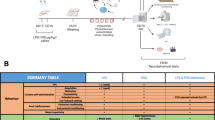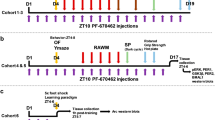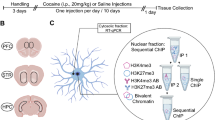Abstract
Sensitization to psychostimulants can be influenced by circadian rhythms. The pineal gland, the main source of circadian melatonin synthesis, may influence behavioral sensitization to cocaine; mice with normal melatonin rhythms do not get sensitized at night. Clock genes such as Period1 (Per1) show rhythmic region- and strain-dependent expression in the mouse brain, and mice mutant for the Per1 gene lack cocaine sensitization. Here, for the first time we show circadian changes of PER1 protein levels in the mouse striatum, a brain region crucial for the development of locomotor sensitization to cocaine. In male C3H/HeJ mice, we found peak striatal PER1 protein levels during the day; this was preceded by a Per1 mRNA peak 16 h earlier. Pinealectomized mice did not show this circadian pattern. We analyzed circadian cocaine sensitization at times when striatal PER1 protein levels in control mice (naive and sham-pinealectomized) were high and low, respectively. Only mice with circadian changes in striatal Per1 expression showed the night-time absence of cocaine sensitization, whereas pinealectomized mice were without circadian changes in striatal Per1 and were sensitized to cocaine regardless of diurnal rhythm. Our results indicate that both the striatal circadian Per1 expression and diurnal locomotor cocaine sensitization are strongly influenced by pineal products. Since we found evidence for the expression of melatonin receptor mRNA in the striatum, we suggest that further studies on pineal-driven mechanisms will help us better understand the mechanisms of drug abuse and identify novel targets for the prevention and/or treatment of addictions.
Similar content being viewed by others
Log in or create a free account to read this content
Gain free access to this article, as well as selected content from this journal and more on nature.com
or
References
Abarca C, Albrecht U, Spanagel R (2002). Cocaine sensitization and reward are under the influence of circadian genes and rhythm. Proc Natl Acad Sci USA 99: 9026–9030.
Andretic R, Chaney S, Hirsh J (1999). Requirement of circadian genes for cocaine sensitization in Drosophila. Science 285: 1066–1068.
Dubocovich ML, Masana MI, Benloucif S (1999). Molecular pharmacology and function of melatonin receptor subtypes. Adv Exp Med Biol 460: 181–190.
Etchegaray J-P, Lee C, Wade PA, Reppert SM (2003). Rhythmic histone acetylation underlies transcription in the mammalian circadian clock. Nature 421: 177–182.
Gaytan O, Lewis C, Swann A, Dafny N (1999). Diurnal differences in amphetamine sensitization. Eur J Pharmacol 374: 1–9.
Gaytan O, Yang P, Swann A, Dafny N (2000). Diurnal differences in sensitization to methylphenidate. Brain Res 864: 24–39.
Goto M, Oshima I, Tomita T, Ebihara S (1989). Melatonin content of the pineal gland in different mouse strains. J Pineal Res 7: 195–204.
Hasel KW, Sutcliffe JG (1990). Nucleotide sequence of a cDNA coding for mouse cyclophilin. Nucleic Acids Res 18: 4019.
Hirsh J (2001). Time flies like an arrow. Fruit flies like crack? Pharmacogenom J 1: 97–100.
Iijima M, Nikaido T, Akiyama M, Moriya T, Shibata S (2002). Methamphetamine-induced, suprachiasmatic nucleus-independent circadian rhythms of activity and mPer gene expression in the striatum of the mouse. Eur J Neurosci 16: 921–929.
Laakso A, Mohn AR, Gainetdinov RR, Caron MG (2002). Experimental genetic approaches to addiction. Neuron 36: 213–228.
Messager S, Garabette ML, Hastings MH, Hazlerigg DG (2001). Tissue-specific abolition of Per1 expression in the pars tuberalis by pinealectomy in the Syrian hamster. Neuroreport 12: 579–582.
Morse D, Sassone-Corsi P (2002). Time after time: inputs to and outputs from the mammalian circadian oscillators. Trends Neurosci 25: 632–637.
Paxinos G, Franklin KBJ (2001). The Mouse Brain in Stereotaxic Coordinates. Academic Press: London.
Prinssen EP, Kleven MS, Vignon J, Kamenka JM, Koek W (1996). Effects of repeated administration of N-[1-(2-benzo(b)-thiophenyl)cyclohexy]piperidine and cocaine on locomotor activity in C57BL/6 mice. J Pharmacol Exp Ther 276: 904–911.
Reppert SM, Godson C, Mahle CD, Weaver DR, Slaugenhaupt SA, Gusella JF (1995). Molecular characterization of a second melatonin receptor expressed in human retina and brain: the Mel1b melatonin receptor. Proc Natl Acad Sci USA 92: 8734–8738.
Robinson TE, Berridge KC (1993). The neural basis of drug craving: an incentive-sensitization theory of addiction. Brain Res Brain Res Rev 18: 247–291.
Roca AL, Godson C, Weaver DR, Reppert SM (1996). Structure, characterization, and expression of the gene encoding the mouse Mel1a melatonin receptor. Endocrinology 137: 3469–3477.
Roseboom PH, Coon SL, Baler R, McCune SK, Weller JL, Klein DC (1996). Melatonin synthesis: analysis of the more than 150-fold nocturnal increase in serotonin N-acetyltransferase messenger ribonucleic acid in the rat pineal gland. Endocrinology 137: 3033–3045.
Sandyk R, Kanofsky JD (1992). Cocaine addiction: relationship to seasonal affective disorder. Int J Neurosci 64: 195–201.
Satel SL, Gawin FH (1989). Seasonal cocaine abuse. Am J Psychiatry 146: 534–535.
Sax KW, Strakowski SM (2001). Behavioral sensitization in humans. J Addict Dis 20: 55–65.
Sircar R (2000). Effect of melatonin on cocaine-induced behavioral sensitization. Brain Res 857: 295–299.
Stanewsky R (2003). Genetic analysis of the circadian system in Drosophila melanogaster and mammals. J Neurobiol 54: 111–147.
Stehle JH, von Gall C, Korf HW (2002). Organisation of the circadian system in melatonin-proficient C3H and melatonin-deficient C57BL mice: a comparative investigation. Cell Tissue Res 309: 173–182.
Sun ZS, Albrecht U, Zhuchenko O, Bailey J, Eichele G, Lee CC (1997). RIGUI, a putative mammalian ortholog of the Drosophila period gene. Cell 90: 1003–1011.
Terwilliger RZ, Beitner-Johnson D, Sevarino KA, Crain SM, Nestler EJ (1991). A general role for adaptations in G-proteins and the cyclic AMP system in mediating the chronic actions of morphine and cocaine on neuronal function. Brain Res 548: 100–110.
Uz T, Manev H (1998). Circadian expression of pineal 5-lipoxygenase mRNA. Neuroreport 9: 783–786.
Uz T, Manev H (2001). Prolonged swim-test immobility of serotonin N-acetyltransferase (AANAT)-mutant mice. J Pineal Res 30: 166–170.
Uz T, Javaid JI, Manev H (2002a). Circadian differences in behavioral sensitization to cocaine: putative role of arylalkylamine N-acetyltransferase. Life Sci 70: 3069–3075.
Uz T, Qu T, Sugaya K, Manev H (2002b). Neuronal expression of arylalkylamine N-acetyltransferase (AANAT) mRNA in the rat brain. Neurosci Res 42: 309–316.
von Gall C, Lewy A, Schomerus C, Vivien-Roels B, Pevet P, Korf HW et al (2000). Transcription factor dynamics and neuroendocrine signalling in the mouse pineal gland: a comparative analysis of melatonin-deficient C57BL mice and melatonin-proficient C3H mice. Eur J Neurosci 12: 964–972.
von Gall C, Schneider-Huther I, Pfeffer M, Dehghani F, Korf HW, Stehle JH (2001). Clock gene protein mPER1 is rhythmically synthesized and under cAMP control in the mouse pineal organ. J Neuroendocrinol 13: 313–316.
von Gall C, Garabette ML, Kell CA, Frenzel S, Dehghani F, Schumm-Draeger PM et al (2002). Rhythmic gene expression in pituitary depends on heterologous sensitization by the neurohormone melatonin. Nat Neurosci 5: 234–238.
Weaver DR, Liu C, Reppert SM (1996). Nature's knockout: the Mel1b receptor is not necessary for reproductive and circadian responses to melatonin in Siberian hamsters. Mol Endocrinol 10: 1478–1487.
Wolf ME (1999). Cocaine addiction: clues from Drosophila on drugs. Curr Biol 9: R770–R772.
Acknowledgements
This research was supported by NIH Grants RO1 DA15072 (TU) and RO1 MH61572 (HM).
Author information
Authors and Affiliations
Corresponding author
Rights and permissions
About this article
Cite this article
Uz, T., Akhisaroglu, M., Ahmed, R. et al. The Pineal Gland is Critical for Circadian Period1 Expression in the Striatum and for Circadian Cocaine Sensitization in Mice. Neuropsychopharmacol 28, 2117–2123 (2003). https://doi.org/10.1038/sj.npp.1300254
Received:
Revised:
Accepted:
Published:
Issue date:
DOI: https://doi.org/10.1038/sj.npp.1300254
Keywords
This article is cited by
-
Effects of Kappa opioid receptor blockade by LY2444296 HCl, a selective short-acting antagonist, during chronic extended access cocaine self-administration and re-exposure in rat
Psychopharmacology (2020)
-
Melatonin receptors: distribution in mammalian brain and their respective putative functions
Brain Structure and Function (2017)
-
Melatonin reduces motivation for cocaine self-administration and prevents relapse-like behavior in rats
Psychopharmacology (2017)
-
Melatonin receptor deficiency decreases and temporally shifts ecto-5′-nucleotidase mRNA levels in mouse prosencephalon
Cell and Tissue Research (2016)
-
Melatonin administration alters nicotine preference consumption via signaling through high-affinity melatonin receptors
Psychopharmacology (2015)



